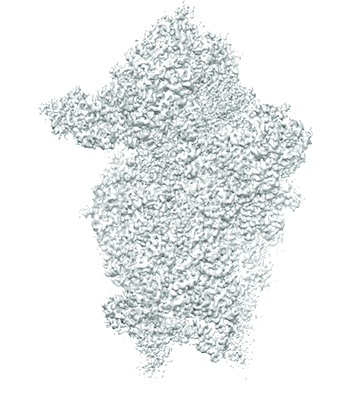EMD-10762
Mammalian 48S late-stage translation initiation complex with histone 4 mRNA
EMD-10762
Single-particle3.48 Å
 Deposition: 12/03/2020
Deposition: 12/03/2020Map released: 08/04/2020
Last modified: 23/10/2024
Sample Organism:
Oryctolagus cuniculus,
Mus musculus
Sample: LS48S IC with histone 4 mRNA
Fitted models: 6yan (Avg. Q-score: 0.351)
Deposition Authors: Bochler A, Simonetti A
Sample: LS48S IC with histone 4 mRNA
Fitted models: 6yan (Avg. Q-score: 0.351)
Deposition Authors: Bochler A, Simonetti A

Structural Insights into the Mammalian Late-Stage Initiation Complexes.
Abstract:
In higher eukaryotes, the mRNA sequence in the direct vicinity of the start codon, called the Kozak sequence (CRCCaugG, where R is a purine), is known to influence the rate of the initiation process. However, the molecular basis underlying its role remains poorly understood. Here, we present the cryoelectron microscopy (cryo-EM) structures of mammalian late-stage 48S initiation complexes (LS48S ICs) in the presence of two different native mRNA sequences, β-globin and histone 4, at overall resolution of 3 and 3.5 Å, respectively. Our high-resolution structures unravel key interactions from the mRNA to eukaryotic initiation factors (eIFs): 1A, 2, 3, 18S rRNA, and several 40S ribosomal proteins. In addition, we are able to study the structural role of ABCE1 in the formation of native 48S ICs. Our results reveal a comprehensive map of ribosome/eIF-mRNA and ribosome/eIF-tRNA interactions and suggest the impact of mRNA sequence on the structure of the LS48S IC.
In higher eukaryotes, the mRNA sequence in the direct vicinity of the start codon, called the Kozak sequence (CRCCaugG, where R is a purine), is known to influence the rate of the initiation process. However, the molecular basis underlying its role remains poorly understood. Here, we present the cryoelectron microscopy (cryo-EM) structures of mammalian late-stage 48S initiation complexes (LS48S ICs) in the presence of two different native mRNA sequences, β-globin and histone 4, at overall resolution of 3 and 3.5 Å, respectively. Our high-resolution structures unravel key interactions from the mRNA to eukaryotic initiation factors (eIFs): 1A, 2, 3, 18S rRNA, and several 40S ribosomal proteins. In addition, we are able to study the structural role of ABCE1 in the formation of native 48S ICs. Our results reveal a comprehensive map of ribosome/eIF-mRNA and ribosome/eIF-tRNA interactions and suggest the impact of mRNA sequence on the structure of the LS48S IC.
